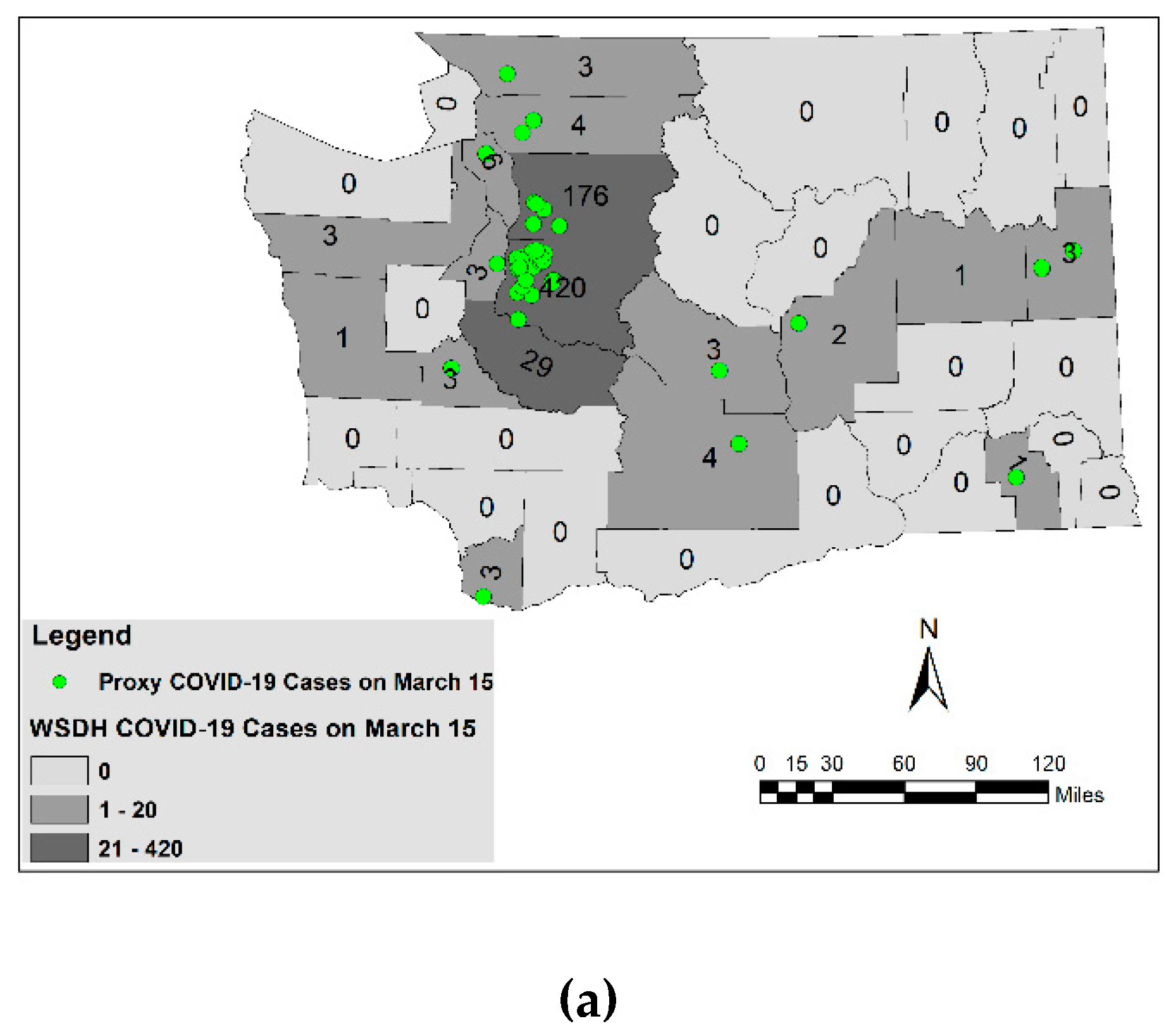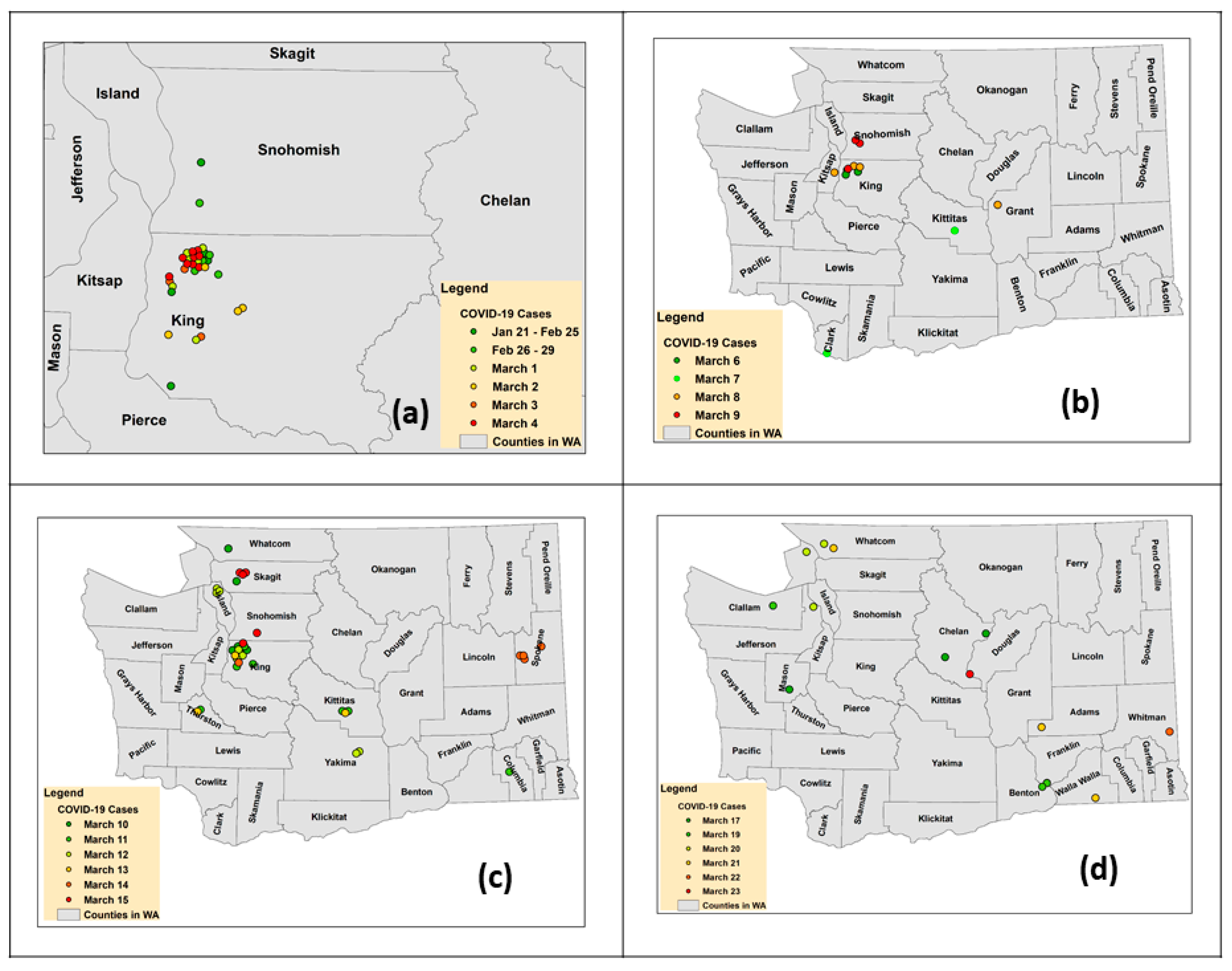Unfolding Events in Space and Time: Geospatial Insights into COVID-19 Diffusion in Washington State during the Initial Stage of the Outbreak
Abstract
:1. Introduction
2. Materials and Methods
2.1. Study Area
2.2. Data Collection
2.3. Mapping Spread of COVID-19 in Space and Time
3. Results
3.1. Spatial Analysis of Initial Spread
3.2. Kernel Density Estimation (KDE) of COVID-19 Cases
3.3. Spatial Distribution of COVID-19 over Time
4. Discussion and Conclusions
Funding
Acknowledgments
Conflicts of Interest
References
- World Health Organization. Disease outbreaks. Available online: https://www.who.int/emergencies/diseases/en/ (accessed on 29 March 2020).
- World Health Organization. Pneumonia of Unknown Cause–China. Available online: https://www.who.int/csr/don/05-january-2020-pneumonia-of-unkown-cause-china/en/ (accessed on 29 March 2020).
- World Health Organization. Naming the Coronavirus Disease (COVID-19) and the Virus that Causes It. Available online: https://www.who.int/emergencies/diseases/novel-coronavirus-2019/technical-guidance/naming-the-coronavirus-disease-(covid-2019)-and-the-virus-that-causes-it (accessed on 29 March 2020).
- Centers for Disease Control and Prevention. How Coronavirus Spreads_CDC. Available online: https://www.cdc.gov/coronavirus/2019-ncov/prevent-getting-sick/how-covid-spreads.html (accessed on 29 March 2020).
- World Health Organization. WHO Director-General’s Opening Remarks at the Media Briefing on COVID-19–11 March 2020. Available online: https://www.who.int/dg/speeches/detail/who-director-general-s-opening-remarks-at-the-media-briefing-on-covid-19---11-march-2020 (accessed on 29 March 2020).
- British Broadcasting Corporation, Coronavirus_ Worst-hit Countries Boost Containment Efforts. Available online: https://www.bbc.com/news/world-51625123 (accessed on 29 March 2020).
- Centers for Disease Control and Prevention. First Travel-Related Case of 2019 Novel Coronavirus Detected in United States_CDC Online Newsroom_CDC. Available online: https://www.cdc.gov/media/releases/2020/p0121-novel-coronavirus-travel-case.html (accessed on 21 January 2020).
- Centers for Disease Control and Prevention. Situation Summary_CDC. Available online: https://www.cdc.gov/coronavirus/2019-ncov/cases-updates/summary.html?CDC_AA_refVal=https%3A%2F%2Fwww.cdc.gov%2Fcoronavirus%2F2019-ncov%2Fsummary.html (accessed on 29 March 2020).
- Washington State Department of Health. Novel Coronavirus Outbreak 2020 (COVID-19)_Washington State Department of Health. Available online: https://www.doh.wa.gov/Emergencies/Coronavirus (accessed on 25 March 2020).
- The New York Times. Coronavirus Slowdown in Seattle Suggests Restrictions Are Working-the New York Times. Available online: https://www.nytimes.com/2020/03/29/us/seattle-washington-state-coronavirus-transmission-rate.html (accessed on 29 March 2020).
- Hua, J.; Rajib, S. Corona Virus (COVID-19) “Infodemic”and Emerging Issues through a Data Lens: The Case of China. Int. J. Environ. Res. Public Health 2020, 17, 2309. [Google Scholar] [CrossRef] [PubMed] [Green Version]
- Johns Hopkins University. Coronavirus COVID-19 (2019-nCoV). Available online: https://gisanddata.maps.arcgis.com/apps/opsdashboard/index.html#/bda7594740fd40299423467b48e9ecf6 (accessed on 29 March 2020).
- Dong, E.; Du, H.; Gardner, L. An interactive web-based dashboard to track COVID-19 in real time. Lancet Infect. Dis. 2020, 20, 533–534. [Google Scholar] [CrossRef]
- World Health Organization. Coronavirus Disease (COVID-19) Situation Dashboard. Available online: https://covid19.who.int/ (accessed on 29 March 2020).
- Kamel Boulos, M.N.; Estella, M.G. Geographical Tracking and Mapping of Coronavirus Disease COVID-19/Severe Acute Respiratory Syndrome Coronavirus 2 (SARS-CoV-2) Epidemic and Associated Events Around the World: How 21st Century GIS Technologies are Supporting the Global Fight Against Outbreaks and Epidemics. Int. J. Health Geogr. 2020, 19, 1–12. [Google Scholar]
- Centers for Disease Control and Prevention. Cases in U.S._CDC. Available online: https://www.cdc.gov/coronavirus/2019-ncov/cases-updates/cases-in-us.html#2019coronavirus-summary (accessed on 29 March 2020).
- Holshue, M.L.; DeBolt, C.; Lindquist, S.; Lofy, K.H.; Wiesman, J.; Bruce, H.; Spitters, C.; Ericson, K.; Wilkerson, S.; Tural, A.; et al. First Case of 2019 Novel Coronavirus in the United States. N. Engl. J. Med. 2020, 382, 929–936. [Google Scholar] [CrossRef] [PubMed]
- The New York Times. Coronavirus Cost to Businesses and Workers_ ‘It Has All Gone to Hell’. Available online: https://www.nytimes.com/2020/03/15/business/economy/coronavirus-economy-impact.html (accessed on 29 March 2020).
- Shekhar, S.; Shekhar, A.H.; The MIT Press Reader. As COVID 19 Accelerates, Governments Must Harness Mobile Data to Stop Spread. Available online: https://thereader.mitpress.mit.edu/contact-tracing-covid-19/ (accessed on 29 March 2020).
- Lyseen, A.K.; Nohr, C.; Sorensen, E.M.; Gudes, O.; Geraghty, E.M.; Shaw, N.T.; Bivona-Tellez, C.; IMIA Health GIS Working Group. A Review and Framework for Categorizing Current Research and Development in Health Related Geographical Information Systems (GIS) Studies. Yearb. Med. Inform. 2014, 23, 110–124. [Google Scholar]
- Xun, S.; Kwan, M.-P. Introduction: Geospatial Health Research and GIS. Ann. Gis Geospat. Health Res. 2015, 21, 93–95. [Google Scholar] [CrossRef]
- Kneebone, E.; Holmes, N. The Growing Distance between People and Jobs in Metropolitan America. Available online: https://www.brookings.edu/research/the-growing-distance-between-people-and-jobs-in-metropolitan-america/ (accessed on 20 November 2019).
- Easton, S.; Ferrari, E. Children’s Travel to School—the Interaction of Individual, Neighborhood and School Factors. Transp. Policy 2015, 44, 9–18. [Google Scholar] [CrossRef] [Green Version]
- Souris, M. Epidemiology and Geography: Principles, Methods and Tools of Spatial Analysis; John Wiley & Sons, Inc.: Hoboken, NJ, USA, 2019. [Google Scholar]
- Associated Press and Herald Staff. Jackson High Student, Infected with Coronavirus, ‘Doing Well’. Available online: https://www.heraldnet.com/news/jackson-high-student-infected-with-coronavirus-doing-well/ (accessed on 29 March 2020).
- Trevor Bedford. Cryptic Transmission of Novel Coronavirus Revealed by Genomic Epidemiology. 2020. Available online: https://bedford.io/blog/ncov-cryptic-transmission/ (accessed on 29 March 2020).
- Shiode, N.; Shiode, S.; Rod-Thatcher, E.; Rana, S.; Vinten-Johansen, P. The Mortality Rates and the Space-Time Patterns of John Snow’s Cholera Epidemic Map. Int. J. Health Geogr. 2015, 14. [Google Scholar] [CrossRef] [PubMed] [Green Version]
- Medium, and Governor Jay Inslee. Inslee Announces “Stay Home, Stay Healthy” Order. Available online: https://medium.com/@GovInslee (accessed on 23 March 2020).
- University of Washington. Moving Classes Online and Concluding the Winter Quarter. Available online: https://www.washington.edu/coronavirus/2020/03/06/moving-classes-online-and-concluding-the-winter-quarter/ (accessed on 29 March 2020).











© 2020 by the author. Licensee MDPI, Basel, Switzerland. This article is an open access article distributed under the terms and conditions of the Creative Commons Attribution (CC BY) license (http://creativecommons.org/licenses/by/4.0/).
Share and Cite
Thakar, V. Unfolding Events in Space and Time: Geospatial Insights into COVID-19 Diffusion in Washington State during the Initial Stage of the Outbreak. ISPRS Int. J. Geo-Inf. 2020, 9, 382. https://doi.org/10.3390/ijgi9060382
Thakar V. Unfolding Events in Space and Time: Geospatial Insights into COVID-19 Diffusion in Washington State during the Initial Stage of the Outbreak. ISPRS International Journal of Geo-Information. 2020; 9(6):382. https://doi.org/10.3390/ijgi9060382
Chicago/Turabian StyleThakar, Vaishnavi. 2020. "Unfolding Events in Space and Time: Geospatial Insights into COVID-19 Diffusion in Washington State during the Initial Stage of the Outbreak" ISPRS International Journal of Geo-Information 9, no. 6: 382. https://doi.org/10.3390/ijgi9060382
APA StyleThakar, V. (2020). Unfolding Events in Space and Time: Geospatial Insights into COVID-19 Diffusion in Washington State during the Initial Stage of the Outbreak. ISPRS International Journal of Geo-Information, 9(6), 382. https://doi.org/10.3390/ijgi9060382



